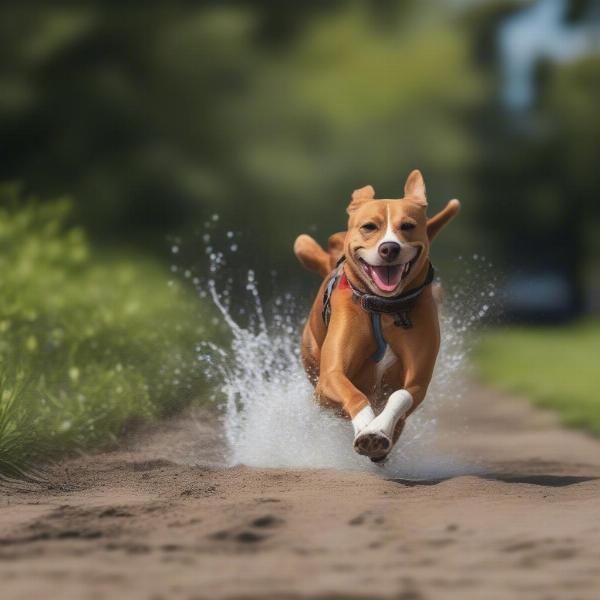Choosing the right weight loss food for your dog can feel overwhelming. With so many options available, it’s crucial to understand what to look for and how to make the best choice for your furry friend’s health. This guide covers everything you need to know about weight loss for dogs food, from understanding the causes of canine obesity to selecting the perfect diet and incorporating exercise.
Understanding Canine Obesity
Just like in humans, obesity in dogs can lead to a variety of health problems, including diabetes, arthritis, heart disease, and even a shortened lifespan. Identifying the cause of your dog’s weight gain is the first step towards a healthier future. Is it overfeeding, lack of exercise, or an underlying medical condition? A visit to your veterinarian is crucial to rule out any medical issues and get personalized advice.
Choosing the Right Weight Loss Food for Dogs
Selecting the best weight loss food for your dog involves considering several factors. Look for food that is lower in calories and fat, but higher in fiber and protein. Fiber helps your dog feel full and satisfied, while protein helps maintain muscle mass during weight loss.
Reading Dog Food Labels for Weight Management
Don’t be fooled by marketing claims. Carefully examine the ingredient list and guaranteed analysis. Look for whole food ingredients, such as lean meats and vegetables, and avoid fillers and artificial additives. The guaranteed analysis provides the minimum percentages of protein, fat, fiber, and moisture in the food.
Types of Weight Loss Dog Food
Several types of weight loss dog food are available, including dry kibble, wet food, and even raw diets. Each type has its pros and cons. Dry kibble is often the most affordable and convenient option. Wet food can be more palatable for picky eaters, while raw diets require careful preparation and balancing of nutrients. Consult your vet to determine the best option for your dog’s individual needs and preferences.
Incorporating Exercise into Your Dog’s Weight Loss Plan
Exercise is a vital component of any successful weight loss program for dogs. Regular physical activity not only burns calories but also improves your dog’s overall health and well-being. Aim for at least 30 minutes of exercise most days of the week. This can include walks, runs, swims, or even playtime in the park.
 Dog exercising for weight loss
Dog exercising for weight loss
How can I tell if my dog needs to lose weight?
A simple way to check is by feeling your dog’s ribs. You should be able to feel them easily without pressing too hard. If you can’t feel them, or if there’s a thick layer of fat over them, your dog is likely overweight.
What are some healthy treats for dogs on a weight loss diet?
Consider healthy treats like small pieces of carrots, green beans, or apples. Avoid high-calorie treats and always factor them into your dog’s daily calorie intake.
How much weight loss is safe for my dog per week?
Generally, a safe rate of weight loss for dogs is 1-2% of their body weight per week. Rapid weight loss can be harmful, so it’s important to work with your veterinarian to develop a safe and effective weight loss plan.
What are some common mistakes to avoid when trying to help my dog lose weight?
Avoid drastic calorie restrictions or sudden changes in diet. These can lead to nutritional deficiencies and other health problems. Gradual changes and consistency are key to successful weight loss.
Conclusion
Helping your dog achieve a healthy weight is a journey that requires commitment and patience. By carefully selecting weight loss food for dogs and incorporating regular exercise, you can significantly improve your furry friend’s quality of life and help them live a longer, healthier life. Remember to consult with your veterinarian for personalized guidance and to address any underlying medical conditions.
FAQ
-
How do I choose the best weight loss food for my dog? Consider factors like your dog’s age, breed, activity level, and any underlying health conditions. Look for food lower in calories and fat, but higher in fiber and protein.
-
Is it necessary to exercise my dog while on a weight loss diet? Yes, exercise is crucial for weight loss and overall health. Aim for at least 30 minutes of exercise most days of the week.
-
How long will it take for my dog to lose weight? The rate of weight loss varies depending on the dog’s individual circumstances. A safe and healthy rate is 1-2% of body weight per week.
-
What if my dog is a picky eater and refuses to eat the weight loss food? Try gradually transitioning to the new food by mixing it with their current food. You can also try warming the food or adding a small amount of low-sodium broth.
-
Can certain medications cause weight gain in dogs? Yes, some medications, such as steroids, can contribute to weight gain. Discuss any medications your dog is taking with your veterinarian.
ILM Dog is your trusted partner in providing the best care for your canine companion. We offer expert advice and resources on everything from breed selection and dog food for sensitive stomachs to pronefra dogs and even doxidyl for dogs. Our commitment to canine health and well-being extends to providing valuable information on nutrition, training, grooming, and more. We also understand the specific needs of different dog breeds and offer specialized guidance to help you choose the right products and services. If you’re looking for the best dougies raw dog food or other specialized options, we have you covered. Contact us today at [email protected] or +44 20-3965-8624 for personalized support. Visit ILM Dog for more information.